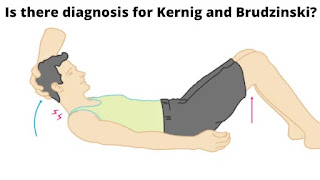Is there diagnosis for Kernig and Brudzinski?

For Kernig and Brudzinski signs physical diagnostic tests include examining the patient. With pain upon passive stretch indicative of a positive sign, the Kernig test involves attempting to straighten the patient's leg out from a flexed knee and hip position. Then LP ought to be delayed and empiric treatment started immediately, if clinical examination of the patient reveals significant papilledema and clinical judgment predicts a high probability of cerebral herniation from LP. CSF, however, will still reveal features characteristic of bacterial meningitis, increased protein count, with a decreased glucose count, including a neutrophilic pleocytosis. LP will reveal gram-negative diplococcic in the CSF, when performed in a timely manner. Being able to rapidly and effectively diagnose patients, hence represent an important method. A third-generation cephalosporin due to the threat of meningococcus, all children suspected of bacterial meningitis should receive empiric therapy.


